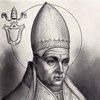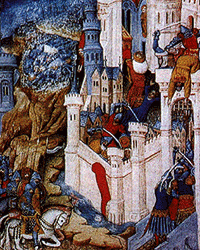He was aided by the intellectual authority of those times – the bishop of Hippo, Augustine (the later saint), who wrote one of his most important texts, “The City of God” because of it. In it he explained the Visigoth invasion as punishment for the sins of pagans and the immoral lifestyle of Christians themselves. But even he was not able to remove from the inhabitants of the Eternal City, the fear of more raids by the more and more daring German tribes. This situation not only did not weaken Innocent’s I authority it actually strengthened it. Those who remained in the city searched for solace in prayer and called on the new Christian God for help, and often by making pious donations and supporting the Church they secured their posthumous life, believing that they will aid them in being placed in a more beneficial location in the afterlife. It is thanks to these donations that parish churches in the city center were built. During the pontificate of Innocent I, Rome, acquired more churches and more saints in this manner. Even before the year 410 the Church of San Marcello was consecrated, the Church of Santa Pudenziana, was completed with outstanding mosaics and most likely the consecration of the Church of San Clemente also took place at that time. It was the pope’s ambition to introduce into the city the cult of the saint martyrs from other provinces, thus enlarging their number by those who had died for the faith, also outside the borders of the Eternal City. In this way he wanted to accentuate the universality of Rome as a center of commemoration and a religious center for all Catholics. An example of this activity is bringing into the city the cult of two saint from Lombardy – Protasius and Gervasius and naming the newly built church on Esquiline Hill in their honor (the later Church of San Vitale). In the same way, St. Chrysogonus came to Rome from the area of Aquileia, becoming the patron of the Church of San Crisogono in the Trastevere founded during the pontificate of Innocent I. The city enriched by the recently erected commemorative basilica dedicated to St. Paul (San Paolo fuori le mura), was able to boast significant churches as well as two principal saint patrons (Peter and Paul). The faith in the miraculous power and intercession began to draw throngs of pilgrims to Rome and it turned out to be stronger than that in the more and more driven out but still not gone, pagan gods. The situation was similar when it came to morality. The pagan rituals deeply rooted in the Roman consciousness, such as funeral parties, wedding parties, or colorful parades (Lupercalia), were gradually replaced or assimilated, and church holidays were introduced in their place. And what of the bloody forms of entertainment the Romans so loved? Slowly, albeit with resistance they too were removed. Such was the case with gladiator fights. It was an accident that caused them to be stopped, after the death of a Greek monk, named Telemachus. According to an ancient legend he threw himself upon the fighting gladiators in order to show his objections for this type of barbaric game, which the audience disliked to such an extent, that they began throwing stones at him. What a paradox, that the impulse for ending the tradition of gladiator fights, was an almost martyr’s death of a monk stoned during Christian times, in front of a Christian ruler Honorius, who at that time, resided in the city on the Tiber. And it was he who proposed elevating Telemachus to the status of martyr and officially forbade such types of entertainment.
Starting with the pontificate of Innocent I, we can speak of the birth of the term “pope” – a dignitary who not only held sway over Rome as the Roman bishop, but whose ambition it was to rule over all the Church. As the successor to St. Peter, meaning the one who “was the rock” upon which the Church in Spain, Gaul or Africa had been built, he believed that he should be not only a spiritual authority but also a legal one in these parts of the empire. From that time the ambitions of bishops of Rome to rule over the Christian world, would grow exponentially, especially because of the increase in the distance between themselves and the Church and emperor in the East. The support of Innocent I, for the bishop of Constantinople, John Chrysostom against Empress Eudoxia, led to a near schism. He also intervened in Africa, where the theories of the monk Pelagius became more and more popular (Pelagianism), and ultimately he excommunicated him believing that he is the last judicial authority in solving doctrinal arguments.
The pope was buried on the Pontian Cemetery at via Portuensis, however few centuries later his remains were transferred to the Church of San Martino ai Monti.










